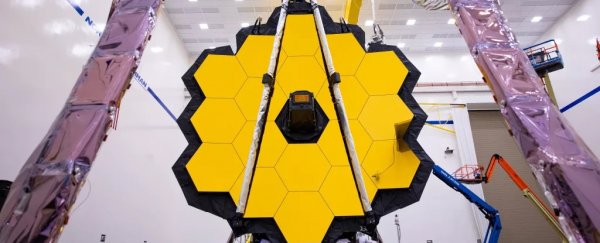We've already seen the breathtaking first image released by the James Webb Space Telescope (JWST). And if you thought that pristine view of thousands of galaxies was impressive, get excited, because we're about to get some more.
In a NASA livestream at 10.30 am EDT (1430 UTC) on 12 July, scientists will unveil the rest of JWST's first full-color images one by one.
You can watch the live stream below.
For those who were frustrated with the lengthy delay ahead of yesterday's first image release by US President Joe Biden (and you weren't alone: we're still haunted by that hold music), don't stress! We've been covering these live updates for a long time and NASA scientists are usually very prompt when it comes to press briefings, so this one should start on time.
And if you need a reminder of how that first pic looked, here it is again.
 (NASA, ESA, CSA, and STScI)
(NASA, ESA, CSA, and STScI)
For context: the image covers a patch of sky roughly the size of a grain of sand held at arm's length by someone standing on Earth – and reveals thousands of galaxies.
This region of space is known as SMACS 0723 – and it's a deep field into the distant Universe.
Hubble has previously photographed the region, but as you can see in the comparison below, the detail provided by JWST is a crazy improvement.
It's finally here! #JWST has released it's first image - the deepest infrared view of the Universe ever! Read more: https://t.co/VjnDIC49td pic.twitter.com/FS6m4QsXkG
— ScienceAlert (@ScienceAlert) July 12, 2022
JWST can peer back in time to just a hundred million years after the Big Bang – virtually the toddler years for our 13.8 billion year old Universe. This is all thanks to its huge primary mirror and ability to see the ancient, stretched-out infrared light of distant space.
Because the Universe is expanding, light from those very first stars shifts from the ultraviolet and visible wavelengths into the longer infrared wavelengths – which JWST can detect in never-before-seen detail.
"If you think about that, this is farther than humanity has ever looked before," Nelson said during a press briefing last week at the Space Telescope Science Institute in Baltimore.
JWST was launched in December last year and is now orbiting the Sun a million miles (1.5 million kilometers) away from Earth.
What else can we expect to see?
NASA has conveniently let us know a list of JWST's first targets.
The Carina Nebula
 The Carina Nebula. (NASA, ESA, Mario Livio (STScI), Hubble 20th Anniversary Team (STScI))
The Carina Nebula. (NASA, ESA, Mario Livio (STScI), Hubble 20th Anniversary Team (STScI))
Located around 7,600 light-years away in the southern constellation of Carina, the Carina Nebula is one of the biggest and brightest nebulae in our skies.
Hubble imaged the Carina Nebula several times, including in infrared; Webb's images are expected to blow Hubble's infrared ones away. After all, Hubble is primarily an optical and ultraviolet instrument.
WASP-96b
One of the objectives Webb has been tasked with is peering into the atmospheres of planets outside the Solar System, or exoplanets. WASP-96b is one of these, and an absolutely fascinating subject for what ought to be the first of many such surveys.
Southern Ring Nebula
 The Southern Ring Nebula. (The Hubble Heritage Team (STScI/AURA/NASA))
The Southern Ring Nebula. (The Hubble Heritage Team (STScI/AURA/NASA))
The Southern Ring Nebula, AKA NGC 3132, around 2,000 light-years away, is a gorgeous, glowing blob in the southern constellation of Vela. Although it shares classification with Carina Nebula, they're more like astronomical opposites: it's the breathtaking, beautiful remains of a binary star that is in the process of dying.
Stephan's Quintet
 Stephan's Quintet. (NASA, ESA, and the Hubble SM4 ERO Team)
Stephan's Quintet. (NASA, ESA, and the Hubble SM4 ERO Team)
Webb has also been peering much farther from home. Stephan's Quintet is a group of galaxies located 290 million light-years away, in a formation so tight that it doesn't look real. In actuality, only four of the five galaxies are interacting; the fifth is much closer to us, only about 40 million light-years away.
SMACS 0723
As mentioned above, for its first deep field, Webb peered into a patch of sky called SMACS 0723, in the southern constellation of Volans.
SMACS 0723 is a particularly good target for this sort of observation, because there are massive clusters of galaxies in the foreground. These act like a giant cosmic magnifying glass. Because of the immense mass, their gravity causes pronounced curvature of the space-time around them, with the effect of magnifying light from more distant objects.
Some parts of this article were taken from previous coverage of the first JWST full-color images.
